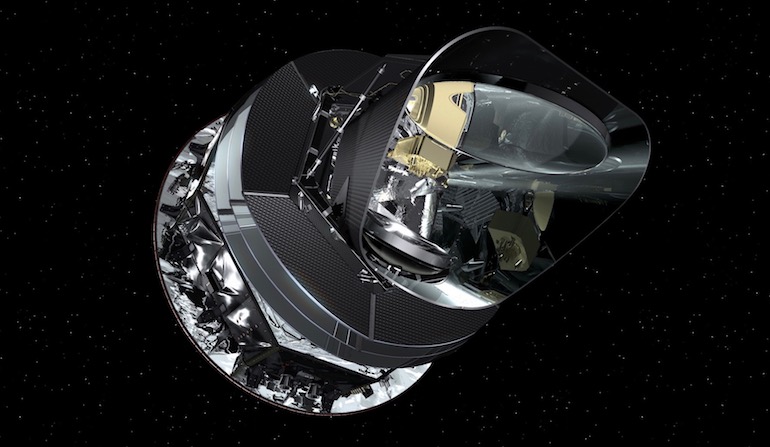 Physics, Earth & Space
Physics, Earth & Space
Confirming the Big Bang: The Recent Decades

In a previous post, I briefly reviewed the early debate among cosmologists over the interpretation of Hubble’s Law. The two leading theories were the Big Bang and Steady State, both based on general relativity (GR). The alternatives, including various flavors of “tired light,” avoided GR. The discovery of the cosmic microwave background (CMB) radiation in 1964 effectively killed off Steady State.
The Holy Grail
The presence of the CMB radiation was a straightforward prediction of the Big Bang theory. But there are many sources of radiation in the universe. How can we be sure the radiation Penzias and Wilson measured was the long-sought after Holy Grail of cosmology? For one thing, there are other aspects of the background radiation that can be measured.
For example, astronomers measure the CMB radiation to be uniform across the whole sky. This is consistent with a cosmological origin and inconsistent with local sources like the Solar System and the Milky Way galaxy. They also measure the precise shape of its spectrum. The Big Bang very specifically requires the spectrum to be that of a blackbody, and that is precisely what is observed (see here and here). Alternative theories, such as “tired light,” are not compatible with a blackbody spectrum and are excluded with a very high degree of confidence.
Fossil “Seeds”
Although the CMB radiation is extremely smooth, Big Bang theory requires that it must display intensity fluctuations with location on the sky. The fluctuations are the fossil “seeds” of later structure formation. By the early 1980s cosmologists were predicting fluctuation amplitudes near one part in 10,000 to one part in 100,000, with the precise amount depending on how much dark matter was included. The fluctuations were observed for the first time in 1992 with the COBE satellite, favoring the predictions with dark matter.
It’s not like dark matter was an ad hoc explanation for the magnitude of the observed CMB fluctuations. Dark matter had already been invoked (over 80 years ago!) first as an explanation for galaxy motions in clusters and later for the rotation curves of individual galaxies.
Another Big Bang prediction concerns the abundances of the isotopes of the elements hydrogen, helium, and lithium. If you extrapolate the expansion of the universe backwards in time far enough, eventually you reach a point when the temperature and density of the matter were high enough for nuclear reactions to occur everywhere. The relative amounts of these light isotopes were predicted as early as 1948 by Ralph Alpher (see here and here). The calculations depend only on the ratio of the amount of ordinary matter to photons. The deuterium (heavy hydrogen) abundance is a particularly sensitive test of the Big Bang, and the latest measurements agree very well with the predicted value (see here and here).
An Age for the Universe
The Big Bang theory also gives us an age for the universe. The latest estimate, based on several cosmological observations, is 13.80 +/- 0.02 billion years. This can be compared to independent age estimates, such as the ages of the oldest stars. The most accurate stellar ages are obtained for stars in clusters. The oldest star clusters are about 12.7 billion years old, comfortably less than the age of the universe.
From careful measurements of the intensity fluctuations in the CMB radiation, it is possible to set constraints on the number of neutrino types. The Planck satellite measurements indicate the number of types is three, in agreement with the results from particle accelerator experiments.
Stringent Tests, High Marks
I could go on describing additional confirmed predictions, but you get the idea. The Big Bang theory has passed a series of stringent tests with high marks. This doesn’t mean we have everything figured out. To be sure, there are some tensions between the Big Bang concordance model and observations of the Hubble constant and the primordial lithium abundance. In each case the observations are modestly in disagreement with the theory. And, it doesn’t mean that the Big Bang theory explains everything. For example, it doesn’t answer why matter particles outnumbered antimatter particles in the early universe. It could just be one of the fine-tuned initial conditions of the universe or it could entail new physics.
In recent decades the Big Bang theory has been conjoined with Inflation theory to explain a few surprising observations. These include the uniformity of the CMB radiation and why the geometry of the universe is so close to flat. Inflation remains controversial. But it is a mistake to believe that overturning Inflation disproves the Big Bang. The Big Bang theory does not need Inflation. All the observations I described above would still point to the universe originating in a hot compact state. The observations that Inflation purports to explain can also be explained as fine-tuned initial conditions.
What is truly remarkable is the fact that we can perform all these observational tests of cosmological models. It didn’t have to be this way. We live in an extravagantly measurable universe and close to the best time to measure it.
Image credit: Planck satellite, by ESA/NASA/JPL-Caltech.
